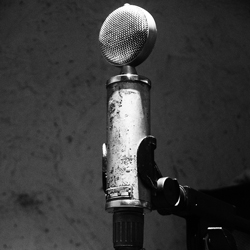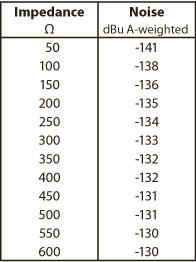
Noise
Microphones and preamps each have their own noise floors.
When selecting a mic preamp you want to know to what degree the preamp’s noise degrades the noise of your microphone.
Different microphone technologies use different terminology to describe noise.
Dynamic Microphones: Dynamic microphone data sheets rarely list noise as a specification since there is no active circuitry to generate noise; there is only a magnet and a coil.
This category of microphone is properly called electromagnetic or electrodynamic. The output noise is very low—so low they just don’t list it.
However, they do generate some noise and it is calculated by knowing the microphone’s impedance.
Obtain the dynamic microphone impedance rating from the data sheet and use Table 2 to convert that into units of dBu, A-weighted.
This noise is the white noise generated by the resistance of the wire used to create the coil, plus a correction factor of 5 dB for A-weighting. (This is somewhat arbitrary, as true A-weighting may decrease the level anywhere from 3-6 dB depending upon the nature of the noise, but agrees with Holman’s article and measured results).
The noise of the measuring standard 150 ohms (200 ohms for Europe) source resistor makes a good noise reference point. From Table 2, find that it equates to -136 dBu (A-weighted; -131 dBu when not).
This means that you cannot have an operating mic stage, with a 150 ohm source, quieter than -136 dBu (A-weighted, 20°C/68°F, 20 kHz BW). Looking at Table 2 confirms that dynamic microphones, indeed, are quiet.
Condenser Microphones: Condenser, capacitor, or more properly, electrostatic microphone technology involves a polarizing voltage network and at least a buffer transistor built into the microphone housing, if not an entire preamp/biasing/transformer network—all of which contribute noise to the output.
Electrostatic microphones are quite noisy compared to dynamic designs, but are very popular for other reasons.
Different manufacturers use different terminology on their electrostatic microphone specification sheets for noise: Self-Noise, Equivalent Noise SPL, Equivalent Noise Level, Noise Floor, and just plain Noise all describe the same specification.
Microphone noise is referenced to the equivalent sound pressure level that would cause the same amount of output noise voltage and is normally A-weighted.

